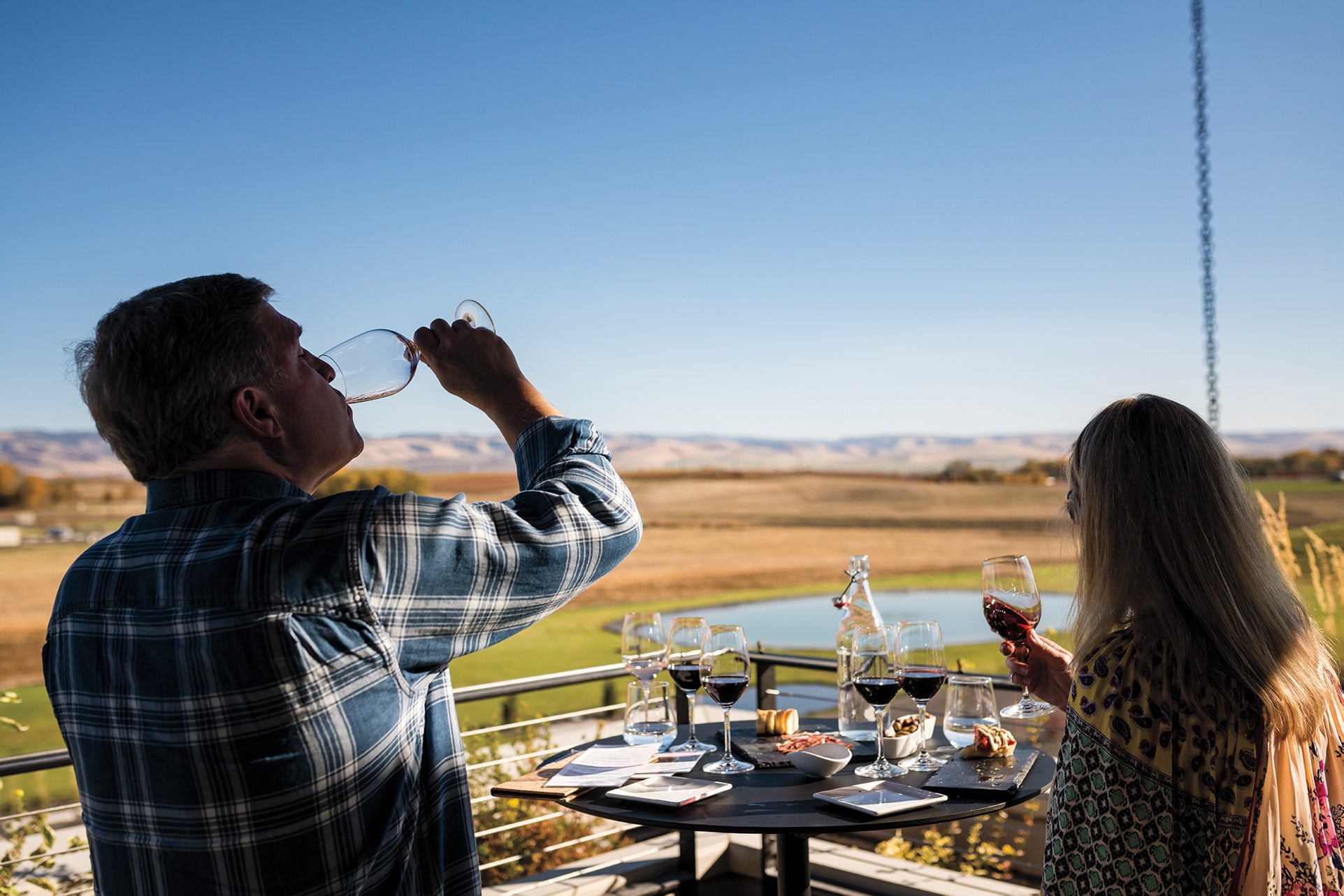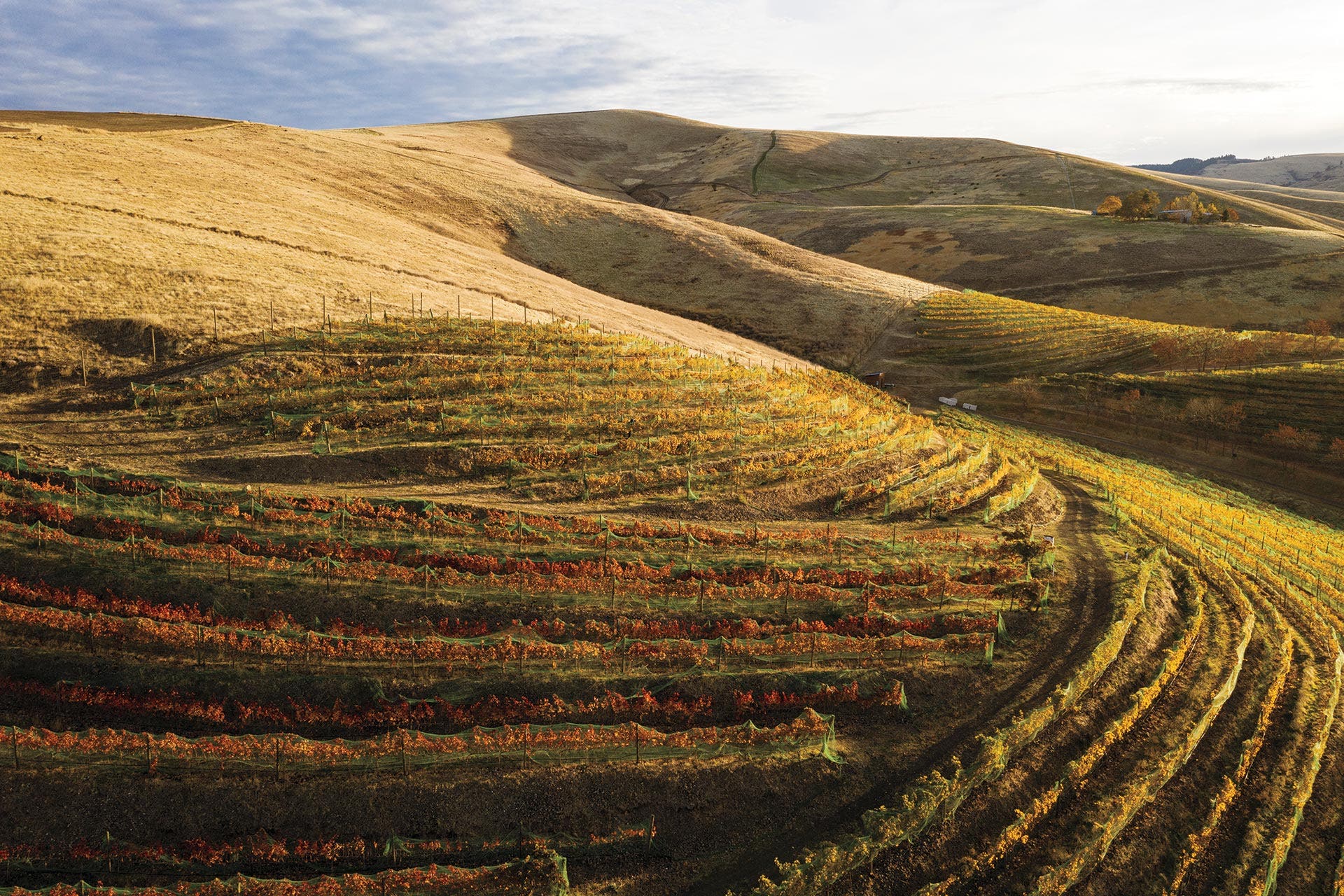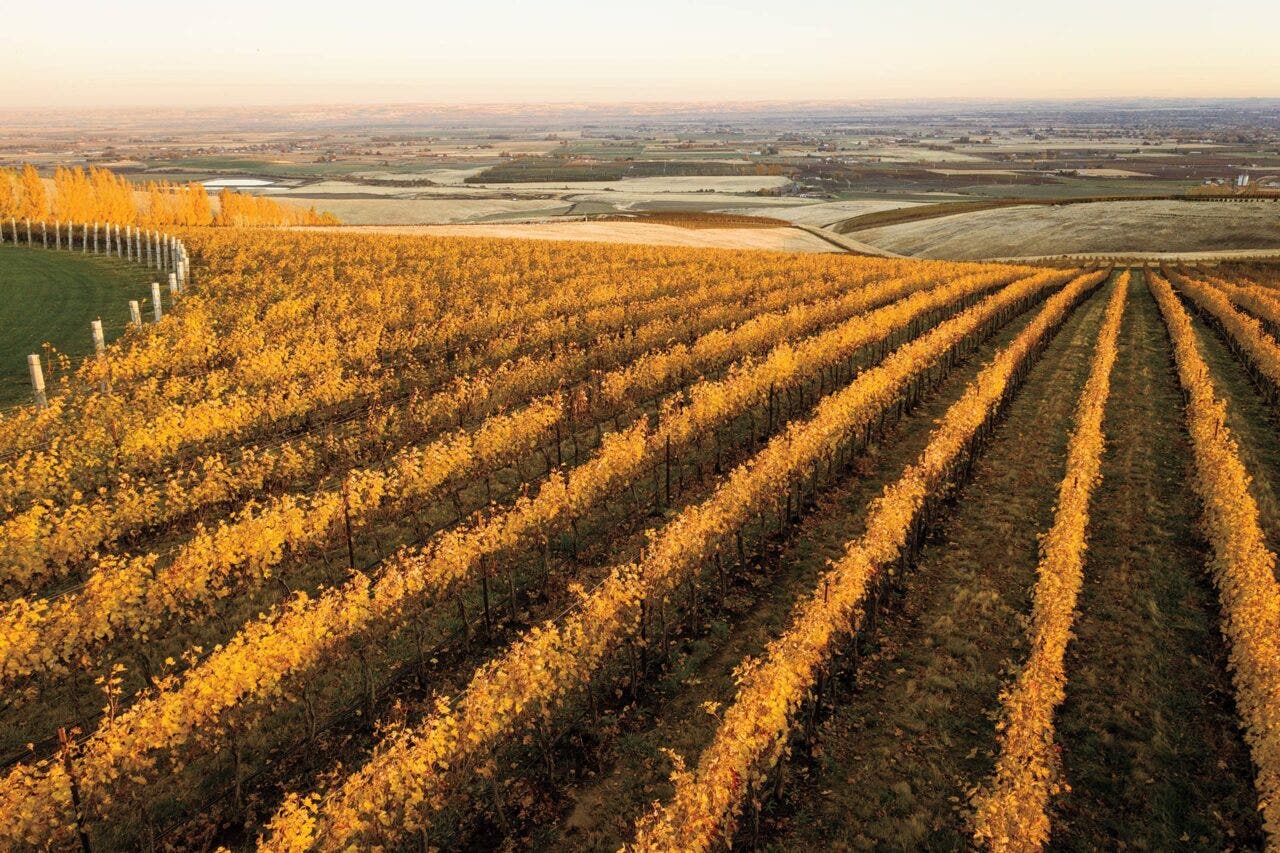Two decades ago, it was said that Walla Walla Valley was a beautiful place to visit and taste wines, but there were few actual vineyards to behold. Today, the appellation teems with thousands of acres of grapevines, including some of the world’s most picturesque and distinctive sites.
After the “big bang” of wineries that opened in the mid-2000s, the valley has entered another phase of aggressive growth. New players have come to the region, wineries are actively exploring different terrains and building construction has boomed.
The wine industry here will be forever changed. Welcome to Walla Walla Valley 3.0.

Outside Wineries Pour In
The newcomer that’s made the largest splash is Valdemar Estates, a project from the fifth generation of the family that founded Spain’s Bodegas Valdemar. When looking for a place to start a new endeavor, its first outside Spain, Walla Walla Valley was the resounding choice.
“We fell in love with Walla Walla—the community, the wines, the vineyards, everything,” says Jesús Martínez Bujanda Mora, CEO of Bodegas Valdemar and Valdemar Estates, who relocated to the U.S. to run the project. “We really believe that this is a top wine region of the world.”
Valdemar’s expansive 21,000-square-foot tasting room and production facility was completed last spring. It offers a unique winery experience, with commanding views of the Blue Mountains, stunning water features, multiple balconies with outdoor seating and a selection of quality Spanish-style tapas to enjoy with your tasting.

In addition to its offerings from Washington, Valdemar also pours some of its Spanish wines. The reception thus far has been strong.
“We wanted a building that would allow us to give a different experience to visitors,” says Martínez Bujanda Mora. “We’ve already had more people [by September] at the winery than we were expecting for the whole year.”
Fellow Pacific Northwest neighbors have set up shop as well. In 2015, Oregon-based Willamette Valley Vineyards purchased two bare vineyard parcels here and established Pambrun, named after founder Jim Bernau’s great grandfather, Pierre Chrysologue Pambrun, who settled in Walla Walla Valley in the 1800s. The winery released wines that same year, made with fruit sourced from neighboring vineyards.
“When we were looking for the next appellation that we thought would bring high quality like the Willamette [Valley] does, we thought of Walla Walla,” says Christine Clair, the winery director.
The company began planting the first of its new plots in 2016, while the second is still being established with vines on order for 2021.
“We fell in love with Walla Walla—the community, the wines, the vineyards, everything.” —Jesús Martínez Bujanda Mora, CEO of Valdemar Estates
Napa Valley stalwart Duckhorn Vineyards opened a tasting room for its Washington brand, Canvasback, this summer. Launched in 2012, Canvasback centers around Cabernet Sauvignon from the nearby Red Mountain American Viticultural Appellation (AVA).
“We’re super committed to Red Mountain, but we like Walla Walla Valley for the access that we have to wine tasters,” says Brian Rudin, winemaker at Canvasback.
Duckhorn’s wide reach is expected to have a significant impact for both the state and the valley. “We’re hoping that, for customers of our California wines, if they have not already discovered Washington, we will be an avenue of discovery for them,” he says.
Two other California-based companies have also made recent acquisitions in Walla Walla. Vintage Wine Estates purchased Tamarack Cellars in 2018. Crimson Wine Group purchased one of the valley’s founding wineries, Seven Hills Winery, in 2016, and, two years later, added 109 additional acres, 66 of which are currently under vine.
“We wanted to be in Walla Walla,” says Nicolas Quille, the interim president and CEO, as well as chief winemaking and operations officer, for Crimson Wine Group. “We believe in the valley. We believe in the tourism industry there.”

A Boomtown of Construction
In addition to Valdemar’s stunning new facility, Walla Walla Valley also bustles with other construction projects.
Doubleback, founded in 2007 by former NFL quarterback Drew Bledsoe, completed its new facility near the Blue Mountains in the spring of 2018. The 14,000-square-foot tasting room and production building were built using reclaimed wood from a barn that stood for more than a century on the ranch of Bledsoe’s great-grandfather.
“I grew up here. Drew grew up here. It was really important [to both of us] that it looked like just another barn in the Walla Walla Valley,” says Josh McDaniels, the winemaker and general manager. The winery is surrounded by one of Doubleback’s estate vineyards, Flying B, which was also the name of Bledsoe’s great-grandfather’s ranch.

Meanwhile, the Rocks District subappellation, named for its cobblestone soils, has long had highly regarded vineyards but offered few wineries to visit. That’s changing, too.
Force Majeure, previously in Woodinville, relocated to Walla Walla and is nearing completion of a new production facility next to one of its estate vineyards. A tasting room is also being constructed in a renovated 1940s schoolhouse adjacent to the property.
“When I first came out here I thought, this is where we need to be,” says Todd Alexander, director of operations and winemaker of Force Majeure. “We’re in a beautiful setting, surrounded by hills. It’s an inspiring place to work and to make wine.”

Nearby, Rôtie Cellars, which has long had a tasting room in downtown Walla Walla, plans to open a facility in the spring. It promises commanding views of the winery’s estate vineyard and the Rocks District.
“I think the valley’s best vineyards are here,” says Sean Boyd, Rôtie’s owner and winemaker. “There’s not too many places you go where your best vineyards are right where you are tasting wine.”
Perhaps most impactful in the long-term will be a shared facility still in the design phase from a partnership between Willamette Valley Vineyards and the city of Milton-Freewater in the Rocks District. The space is intended to produce and feature the winery’s two Walla Walla labels, the aforementioned Pambrun and Maison Bleue, purchased in 2018, in addition to other producers that make Rocks District wines.
“I grew up here… It was really important that [the winery] looked like just another barn in the Walla Walla Valley.” —Josh McDaniels, winemaker/general manager of Doubleback
“Right now, there isn’t really a significant cluster of wineries on the Oregon side [of the Walla Walla Valley] to draw visitors down,” says Clair. “We feel like, if we start with a collective where people can taste multiple representations from the appellation along with our wines, that will help promote the area.” The project is currently slated to begin construction in 2022.
In addition to winery construction, the Rocks District is a hotbed of vineyard planting. Valdemar Estates, Doubleback, Willamette Valley Vineyards, Force Majeure and others have recently purchased land or existing vineyards. Around 330 acres are currently under vine, but that figure is expected to increase dramatically.
“Within the next decade, I can guarantee the Rocks District is going to grow more than 100% in terms of planted acreage,” says Stephen J. Robertson of Delmas Wines, which owns SJR Vineyard in the area.
Vineyard Exploration Abounds
Other areas in Walla Walla Valley have also experienced significant expansion. SeVein, a 2,700-acre parcel of land in the southern part of the valley, has seen a number of producers purchase land and plant vineyards, including Betz Family Winery, Willamette Valley Vineyards, JM Cellars and newcomer Grosgrain Vineyards. The vineyards that have borne fruit show fascinating differences, both from other areas of the valley and from each other.
Doubleback has two vineyard sites within SeVein. “They are on the same hillside, maybe a half-mile apart, but they are completely different,” says McDaniels.
The winery’s Bob Healy Vineyard is warmer and produces riper, more lush flavors. McQueen Vineyard, in contrast, is windier, up along a ridgeline, where, McDaniels says, “you see acid retention like I’ve never seen before. We pick Cabernet at those two sites three weeks apart.”
Farming in the North Fork of the Walla Walla River is “extreme vineyard management,” says Ryan Driver, vineyard manager at Tertulia Cellars.
Another area in the valley that’s created buzz is the picturesque North Fork of the Walla Walla River, with its rolling hills and valleys.
Christophe Baron, who pioneered planting in the Rocks District in 1997 at Cayuse Vineyards, was the first to plant successfully in the region. He established a vineyard where the North Fork meets the Walla Walla River in 2011.
“It’s haute-couture farming,” says Baron of the launch of Hors Categorie Vineyard. Workers plow the 40-plus degree slope of fractured basalt soils with a winch attached to a truck at the top of the hill. The site produces a singular expression of Syrah.

Other wineries have followed. Tertulia Cellars planted its Elevation Vineyard in the North Fork of the Walla Walla River in 2013, with part terraced and planted to Bordeaux varieties. The rest is on a 38-degree slope of fractured basalt, planted to Rhône varieties.
“It’s extreme vineyard management,” says Ryan Driver, vineyard manager at Tertulia Cellars, of farming in the area.
The North Fork is considerably higher in elevation than most vineyards regions in Walla Walla Valley, or in Washington for that matter. The area itself falls on the Oregon side of the valley.
Vineyard elevations range from 1,500–2,200 feet. Due to its proximity to the Blue Mountains, the area receives enough rain to dry-farm, a rarity in the larger Columbia Valley, where irrigation is the norm.

“We believe that it is going to be, if not the most amazing, unique and exciting place in the Pacific Northwest, it’s going to be very close,” says Martínez Bujanda Mora, who purchased land in partnership with Force Majeure in the North Fork. “It has all the ingredients.” He’s slated to begin planting in 2021.
Areas elsewhere in the valley are being newly farmed, too. The 150-acre Eritage Vineyard, north of downtown Walla Walla, for instance, was planted in 2014.
“There’s a lot happening,” says Marty Clubb, co-owner and managing winemaker at L’Ecole No. 41, one of the valley’s founding wineries. “[Walla Walla Valley] is growing faster in terms of acres planted per year than it’s ever grown.”
A Valley Transformed
The valley’s recent growth isn’t limited to wine producers. Three restaurants have opened downtown in the last year, a significant development for a town with just more than 30,000 residents. Two longstanding restaurants have also relocated into expanded spaces.
Work has begun on a new inn and spa downtown, with an additional four-star hotel planned as well. Meanwhile, The Finch, which officially opened this fall, has been fully renovated by a group based in Bozeman, Montana, with connections to Walla Walla.
Perhaps most impressively, a luxury resort, the first of its kind in the valley, opened within Eritage Vineyard in 2018. It features rooms that overlook the vineyard, rolling wheat fields and the Blue Mountains. The resort has its own restaurant, with a menu designed by James Beard Award-winning chef Jason Wilson, culinary director for Fire & Vine Hospitality.
And, of course, there is a steady drumbeat of impressive new wineries opened by graduates of the local community college’s wine program, including Prospice Wines and Elephant Seven.
If it seems like there’s a lot going on, it’s because there is. The area has taken on a tangible sense of energy.
“I used to feel like I knew what was going on in the valley. Now I feel lost, and I live here,” says Clubb with a laugh.
Despite the swift pace of change, few have complaints.
“There’s been a lot of growth, but it’s a lot of good growth,” says McDaniels. “Everyone coming here is a really good thing for all of us. It’s a really competitive market, and any time there is more competition, it pushes us all to be better.”
Last Updated: May 5, 2023















